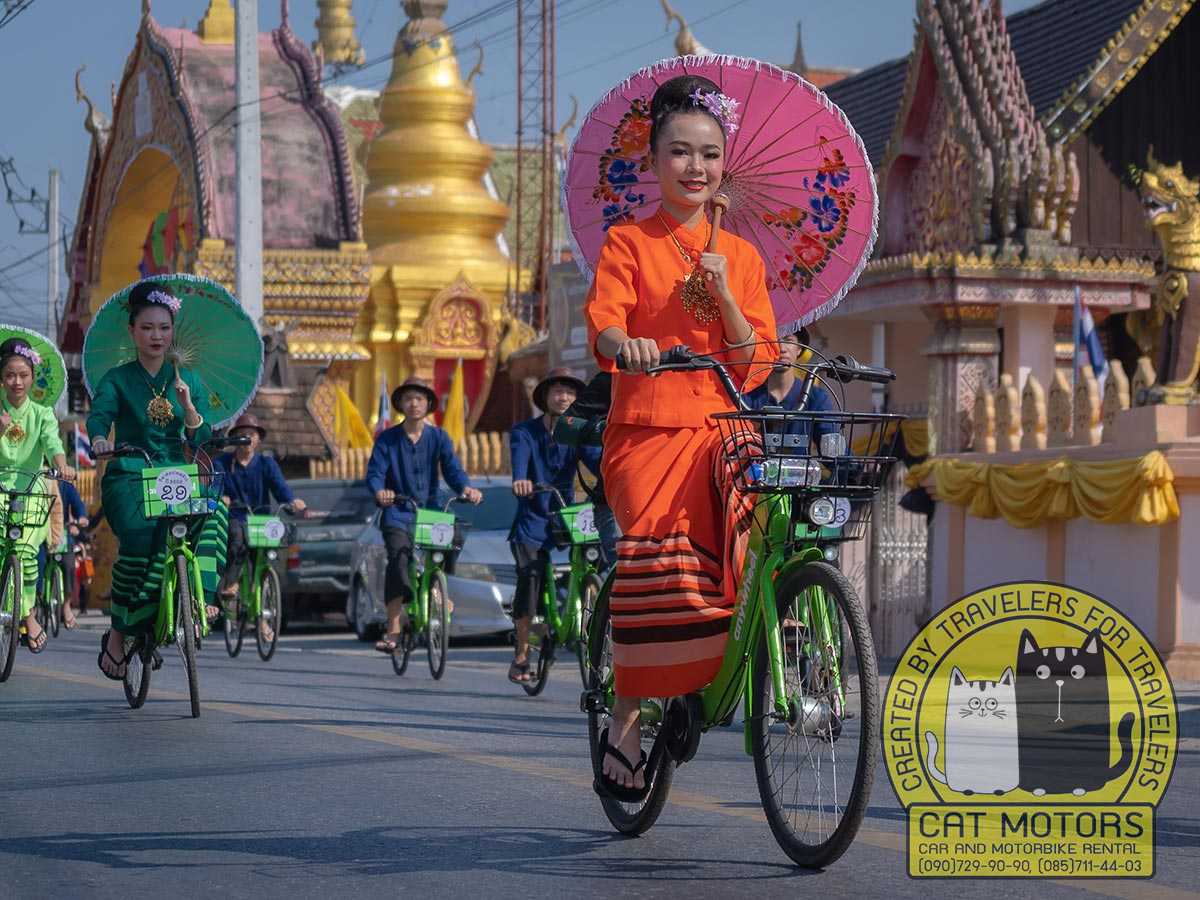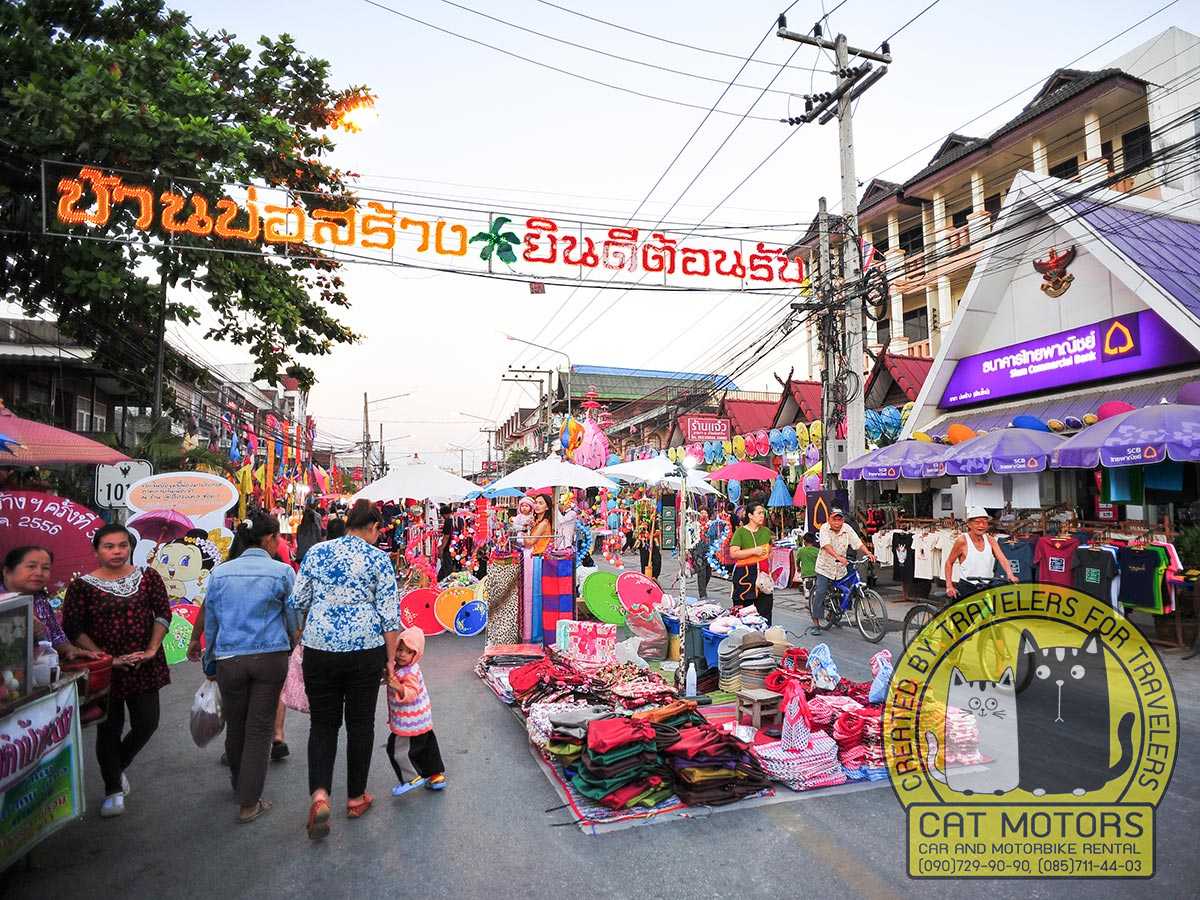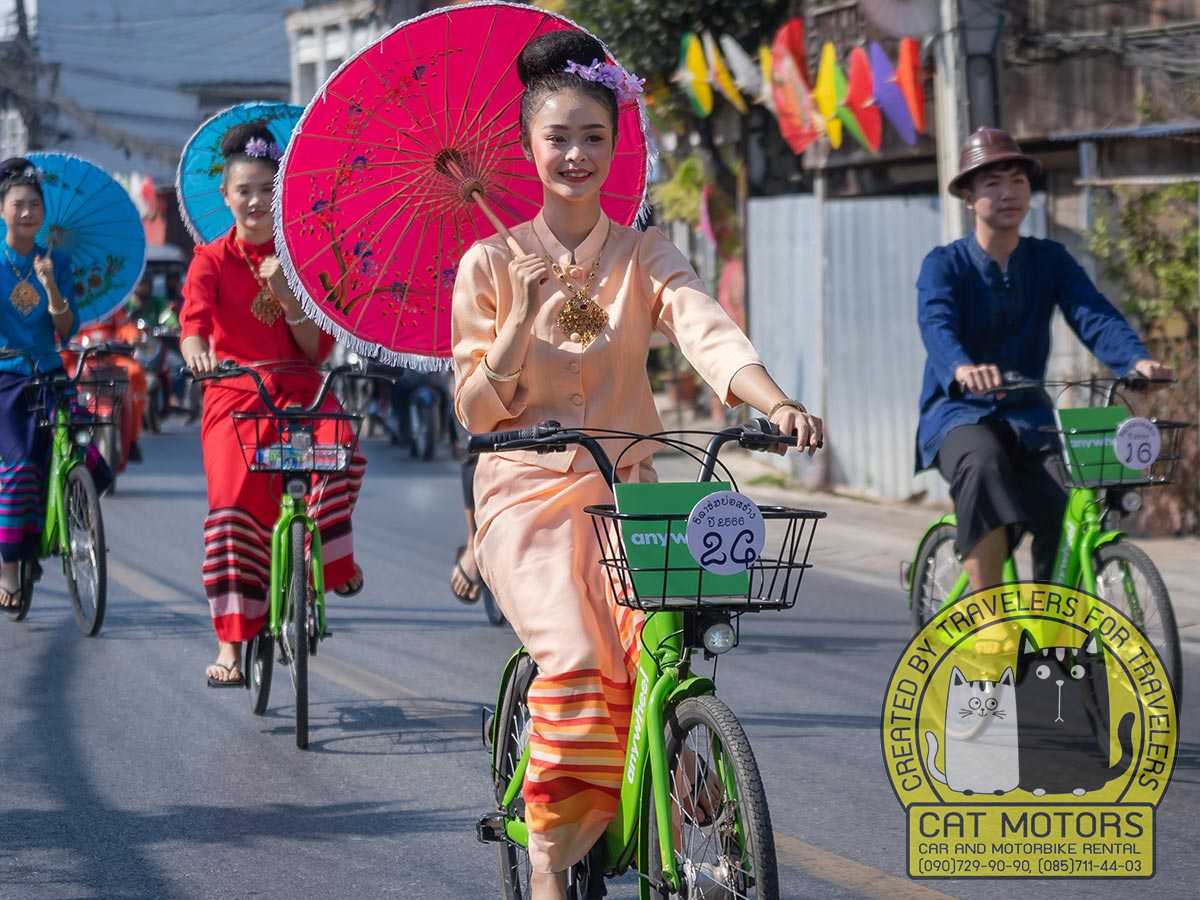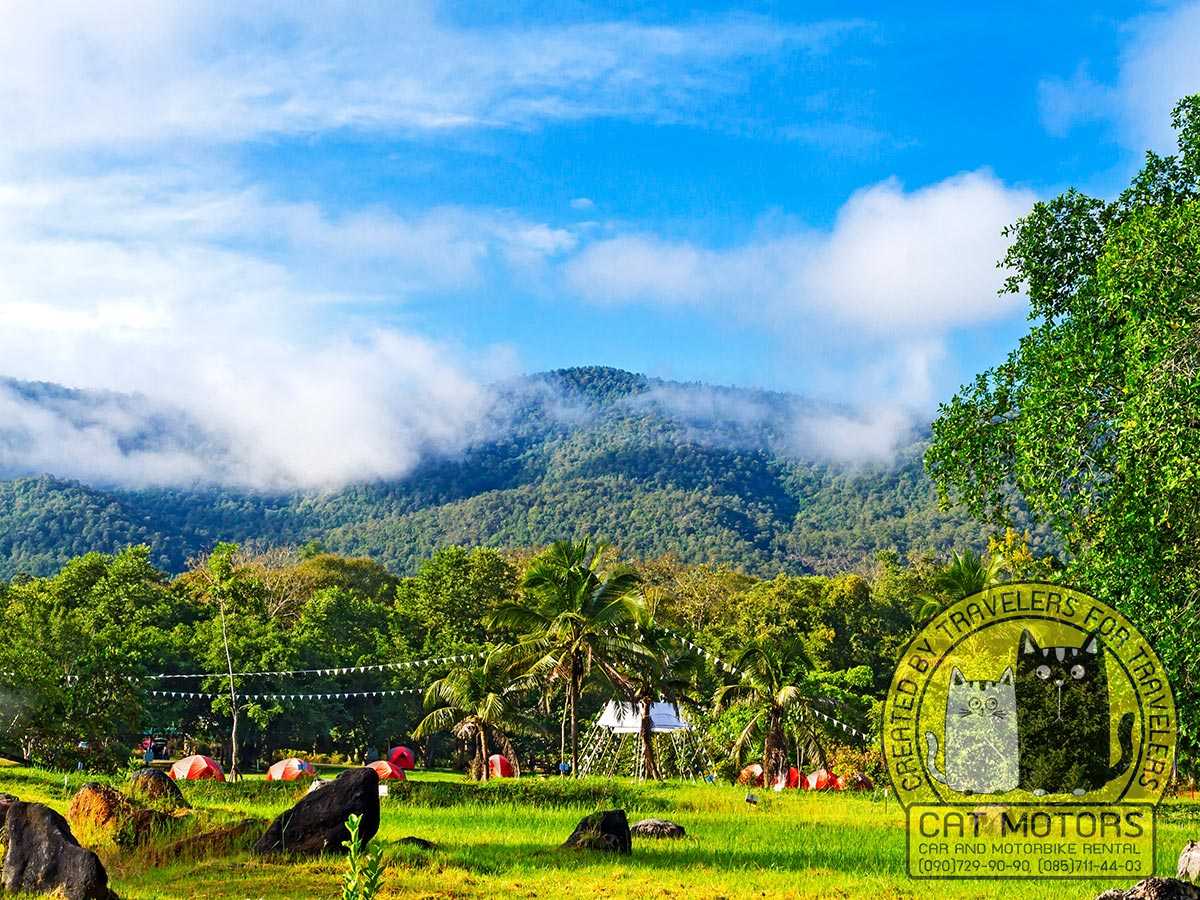Discover San Kamphaeng: A Handicraft Paradise Awaits You!
Situated in the picturesque province of Chiang Mai, Northern Thailand, lies the enchanting district of San Kamphaeng. With its rich cultural heritage, captivating history, and vibrant handicraft industry, San Kamphaeng has become a haven for those visitors seeking a deeper cultural immersion in Thai traditions and an appreciation for its artisanal craftsmanship.
San Kamphaeng is known for craft villages and markets along quiet local roads. We provide scooter rental in Chiang Mai so you can stop wherever you like. Scooters are available in 125–160 cc for local routes and 300–350 cc for longer extensions.

Centuries ago, the district served as a key trade route connecting China and Myanmar to the Kingdom of Lanna. This strategic position brought forth a unique blend of Thai, Chinese, and Burmese traditions, and today, San Kamphaeng is a living memorial to this multicultural heritage.
This comprehensive guide will convince you to make a special trip to this handicraft hub as we shine the spotlight on the incredibly talented San Kamphaeng community’s unique art and crafts, local must-see attractions, and celebratory festivities.
Understand The Significance Of San Kamphaeng's Handicrafts
San Kamphaeng has gained widespread recognition as the heartland of Thai handicrafts, where locals create stunning products using ancient techniques handed down through the generations. The district boasts a flourishing industry that produces an impressive array of handmade products, including silk, ceramics, silverware, woodcarvings, and traditional umbrellas.
The San Kamphaenge handicraft industry serves as a catalyst for community development. Residents, especially women, have found empowerment through employment opportunities in the local handicraft sector. These individuals have become vital contributors to their community’s economic growth by honing their skills and showcasing their artistic talents.
The handicraft industry in San Kamphaeng also plays a vital role in preserving cultural traditions. Artisans, often working within family-run businesses, pass their skills and techniques from generation to generation, ensuring the continuity of these ancient crafts.
San Kamphaeng’s rich cultural heritage and vibrant handicraft industry have made it a must-see destination for domestic and international tourists. Visitors are not only treated to a visual feast of artistic creations but also get to immerse themselves in the local culture through workshops, demonstrations, and cultural festivals.
Enjoy Retail Therapy At Local Markets
San Kamphaeng offers a delightful shopping experience with its vibrant markets and handicraft villages. Exploring these markets allows visitors to witness the bustling trade and discover unique treasures crafted by local artisans.
Bo Sang Umbrella Village
Just a short distance from San Kamphaeng, a rainbow of color illuminates Bo Sang Umbrella Village (Google Map), famous for its handcrafted paper parasols and umbrellas. A stroll around the enchanting Umbrella Making Center allows visitors to witness the entire process of making these beautiful umbrellas.
The process begins with the artisans making the special Sa paper from scratch. Then they build the bamboo frames, at which point they fasten the cut paper to the frame with string. These beautiful umbrellas may seem like pretty but useless souvenirs; however, they are painted with an oil polish making them waterproof and valuable in the rain!
Bo Sang Umbrella Village has been operating its production line in a similar way for the last 100 years, but the craft was brought to the village centuries ago by a Buddhist monk, Phra Inthaa. Legend recounts that, on a long journey to Burma (present-day Myanmar), someone gave the monk a paper umbrella to protect him from the harsh sun as he traveled.
When Phra Inthaa visited the village where the umbrella had been created, he realized Bo Sang had all the resources necessary to craft these beautiful items and that making these umbrellas could be an excellent source of post-harvest income for the people in his village. He studied the skills and techniques and taught them the craft on his return. Now it is an entrenched tradition in Bo Sang.
San Kamphaeng Handicraft Village
As the name suggests, this handicraft village (Google Map) offers an immersive experience of traditional Thai craftsmanship. As visitors wander down the main street, they will come across a huge variety of studios and artisans producing traditional Thai handicrafts of the highest quality.
A tour through the village offers a bird’s eye view into silk weaving, pottery making, silverware crafting, and woodcarving. Visitors can stop at each factory to observe the making of each craft from beginning to end. When you’ve feasted your eyes on these incredible artworks, there are plenty of showrooms and shops where you can purchase souvenirs from this memorable excursion.
Local Markets
One thing we can say about Thailand is that this beautiful country is not short on markets. Beyond the dedicated handicraft villages, San Kamphaeng boasts several local markets that offer an authentic Thai shopping experience. These markets allow visitors to mingle with the locals and explore a wide range of goods, including fresh produce, traditional snacks, textiles, and handicrafts.
Some of the favorite San Kamphaeng markets include the following:
San Kamphaeng Saturday Walking Street
At 5 pm on a Saturday, the local main street morphs into one of the most popular markets in San Kamphaeng. The list of goods is endless, and it’s a great place to buy souvenirs without it costing the proverbial “arm and a leg.”

Typically, food to suit all tastes and budgets is available. San Kamphaeng is part of the silver district, so there are also several silver shops in the area.
Address: North Ridge Soi 1/1, San Kamphaeng (Google Map).
Cham Cha Market
This Saturday market is a small, chic market away from most of the typical tourist areas, selling quality homemade handicrafts, souvenirs, clothes, and food. There is also a little coffee shop and a pizza restaurant. The clientele is mainly local, so prices are more reasonable and not inflated for tourists.
Address: 13-16, Moo 2, Soi 11, San Kamphaeng (Google Map)
Charoen Charoen Market
This fresh food market is open daily from 7 am to 7 pm. It has a reputation for being exceptionally clean with super fresh produce. Twice weekly, on Tuesdays and Fridays, there is an evening walking street here; There is sufficient parking, and you will also find an ATM for easy banking.
Address: 555, Moo 6, Chiang Mai – San Kamphaeng Road (Google Map)
Be Inspired At The Traditional Workshops
San Kamphaeng, a district renowned for its rich cultural heritage and vibrant handicraft industry, is home to many traditional workshops. These workshops provide an immersive and educational experience, allowing visitors to witness the intricate processes and techniques involved in various art forms.
Learn The Art Of Silk Weaving
Silk weaving is a cherished art form in San Kamphaeng, and several places offer an up-close look at this intricate process. Skilled weavers, often using traditional handlooms, transform fine silk threads into exquisite fabrics adorned with intricate patterns.
Visitors can watch the dyeing of silk threads, followed by the meticulous weaving process. These workshops also provide an opportunity to learn about the history and significance of silk in Thai culture and the unique patterns and motifs employed in the craft.
The documented history of Thai silk dates back to the 13th century, when aristocrats and royalty used it for clothing and décor purposes. Weavers used plants and insects as dyes to manufacture rich, colorful silks.
At the Thai Silk Village, visitors can watch the silk-weaving process, which starts with silkworms producing threads ranging from gold to light green. The women working in these workshops combine single threads into a thicker fiber, hand-reeling them onto a spindle to make a usable strand of silk.
They soak the silk in hot water, bleach, and dye it. Then the intricate weaving process begins, as these talented artisans produce their rich and colorful silk fabric using traditional hand looms. The village sells stunning silk scarves and shawls with Lanna patterns and motifs.
Paper Making Studios
San Kamphaeng is renowned for its traditional paper making, known as “sa” paper, used for making umbrellas and parasols. At the workshops, visitors can observe the meticulous process of creating paper from the bark of mulberry trees.
Artisans demonstrate how the bark is boiled, pounded, and transformed into a pulp, then skillfully spread onto screens to form sheets of delicate paper.
The workshops showcase various techniques, including marbling and decorative paper making, allowing visitors to appreciate the artistry and creativity in this ancient craft. The artisans create an array of items from this paper, ranging from ordinary stationery, greeting cards, and notebooks to more decorative pieces, like picture frames, lanterns, and fans.
Watch Traditional Pottery Creation
Baan Celadon and Siam Celadon are two San Kamphaeng factories that produce traditional Thai Celadon ceramics. The word Celadon refers to a jade-green glaze applied to the pottery items. Historically, all Celadon ceramics were this color, but in modern times, they also use a blue glaze and paint brightly colored designs on the pieces.
Unique Thai characteristics of Celadon ceramics include the olive green shade and ivory stripes. They also typically use specific patterns and motifs, such as flowers, fish, and wheels, when painting dishes and bowls. Visitors can observe the artists at work, and plenty of items are available for purchase in the shops.
Woodcarving Workshops
Woodcarving has been a celebrated art form in San Kamphaeng for centuries. At the wood carving workshops in the handicraft village, visitors can observe master artisans skillfully transforming blocks of wood into intricately carved sculptures, furniture, and decorative items.
These workshops showcase the various carving techniques, highlighting the precision, patience, and artistic vision required to create these masterpieces. Visitors get to witness the delicate detailing, learn about the symbolism behind the designs, and gain insights into the cultural significance of carving in the Thai tradition.
Woodcarving is a traditional handicraft passed down from generation to generation since the Sukhothai period (1238 – 1438). Many ancient Buddhist temples are evidence of the intricate carving techniques, as they contain ornamental doors, windows, and other wooden parts still intact today.
Baan Jang Nak
A wood carving must-see destination in San Kamphaeng is Baan Jang Nak, a museum dedicated to carved wooden elephants. Life-like wooden elephant statues and wall decorations cover the entire museum in a mind-blowing artistic display inside and outside this incredible museum.
The museum houses the work and collections of Khun Pech Viriya, who is often found hard at work on his elephants when visitors stop by. The carvings are very detailed, and many elephants look as if they’re alive, including the mammoth near the entrance!
Baan Jang Nak is not a widely known attraction and is on a fairly secluded side street. But there is a coffee shop on-site to refuel after you’ve walked through the museum and watched the master carver work his magic.
Opening hours: Monday – Friday: 8 am – 5 pm; Weekends: 9 am – 5 pm
Address: 56/1, Moo 2, Buakkang, San Kamphaeng (Google Map)
Celebrate Thai Culture And Tradition In San Kamphaeng
With its vibrant cultural heritage, San Kamphaeng is a hub of festivities and events that showcase the district’s rich traditions. The Bo Sang Umbrella Festival and the Songkran Festival are two prominent celebrations in San Kamphaeng. Let’s explore these colorful and joyous occasions.
Bo Sang Umbrella Festival
This festival is a cherished event that celebrates the artistry and cultural significance of traditional Thai umbrellas and parasols. This lively festival attracts visitors from near and far, held annually in the village of Bo Sang, just a short distance from San Kamphaeng.
During the festival, the streets of Bo Sang come alive with vibrant displays of colorful umbrellas and parasols. The festivities feature parades with traditional music, dance performances, and contestants in the Miss Bo Sang Beauty Pageant riding bicycles down the street clad in traditional outfits carrying colorful parasols.

Additionally, there are food stalls, cultural exhibitions, and local performances, providing a comprehensive immersion into the rich heritage of umbrella-making in Bo Sang.
Songkran Festival
The Songkran Festival is a renowned Thai New Year celebration marked by joyful water fights and traditional ceremonies. In San Kamphaeng, the festival takes on a unique charm, blending ancient traditions with modern revelry.
At the start of the festival, many folks spring-clean their houses in preparation for the new year. Locals visit Buddhist temples and pour water over the Buddha statues and the monks’ hands as a sign of respect and seek blessings for the coming year. There is also an alms-giving ceremony.
Following the religious observances, the lively water fights begin. People splash and spray one another, symbolizing the washing away of past misfortunes and the welcoming fresh start.
During Songkran, which usually falls between April 13th and 15th, locals and visitors gather at the San Kamphaeng Hot Springs area to participate in water-based festivities. The hot springs, believed to have cleansing and purifying properties, play a significant role in the traditional rituals associated with the festival.
In addition to the water fights, visitors can enjoy cultural performances, traditional music, and dance shows. Food stalls offering local delicacies are also available, offering visitors a chance to savor the flavors of San Kamphaeng.
It’s worth noting that while the Bo Sang Umbrella and Songkran festivals are the highlights in San Kamphaeng, the district also celebrates other traditional Thai events, such as Loi Krathong and Yi Peng (the Lantern Festival). These events display local customs and traditions, offering visitors an opportunity to understand Thai culture better.
Visit San Kamphaeng's Other Local Attractions
San Kamphaeng may be the handicraft hub of the region, but it also has many other tourist attractions that are unmissable destinations.
Dutch Farm
Even when you’re on vacation in a fabulous foreign country like Thailand, sometimes it’s still good to flee the chaotic city and enjoy some fresh country air. Dutch Farm is open to the public for visits to enjoy the countryside. The admission fee is 100 baht for adults and 30 baht for children.

Children can ride Shetland ponies and feed the animals, including the geese and sheep. Visitors can walk or cycle around the farm, try their hand at shearing them, and enjoy the stunning flowers growing on-site. They can also enjoy refreshments at Thung Na Coffee Shop on the premises.
Opening hours: from 9 am to 6 pm
Address: 56, Moo 5, On Tai, San Kamphaeng District (Google Map)
MAIIAM Contemporary Art Museum
This art museum opened in 2016, founded by the Bunnag-Beurdely family. Jean Michel Beurdeley, his late wife, and his son gathered a massive art collection and wanted to share it with the public.
MAIIAM is located in a transformed warehouse, though from the outside, you would never agree. The entire building is covered with tiny mirror tiles, shimmering like a super-modern corporate structure.
The family collection includes artworks from some significant Thai artists, including Kamin Lertchaiprasert, Chatchai Puipi, and Montien Boonma. The lower level houses a temporary exhibition dedicated to the history of the founding family and the art of Jao Jom Iam, who is related to them. The upper floor has a hall with a permanent art collection and two smaller display rooms.
Opening hours: Every day except Tuesday: 10 am – 6 pm. Closed on Tuesdays
Admission Fee: 150 baht for adults, 100 baht for students, free for kids under 12.
Address: 122, Moo 7, Tonpao, San Kamphaeng (Google Map)
Muang On Caves
The stunning Muang On Cave system is just a short distance from San Kamphaeng Hot Springs. Exploring the caves is not for unfit or ailing individuals. You must climb a steep flight of Naga-flanked stairs to get to the caves’ entrance. Upon entering the cave, you immediately walk down several flights of stairs and pass through narrow rock openings to reach the main cavern.
The main cavern contains a 30-foot Buddha statue reclining under a fossilized dinosaur skeleton. The cave system is full of beautiful stalactites and stalagmites, with one 10-foot wide and 30 feet tall stalagmite called Jedee Mae Nomm Fah. As you meander through the caves, you will notice numerous shrines established because the Buddha was their first visitor.
Historically, the locals also took refuge in Muang Cave from attacking Burmese armies. When things got sticky, the Thai community would pack up their supplies and head for the hills or, in this case, the caves.
Opening Hours: 8 am – 5 pm
Admission Fee: 30 baht
Address: Q6PQ+G6P, Ban Sa Ha Khon, Mae On District (Google Map)
Wat Pa Tueng
Wat Pa Tueng (Google Map) is a beautiful teak temple set in a rural community in San Kamphaeng. Locals visit the temple to worship one of its founding monks, Luang Pu La, whose body lies in a coffin in the sermon hall. Luang Pu La died in 1993 and was embalmed and covered in gold leaf. His body is still intact.
People believe he could see into the future because he saved the lives of many due to a premonition. He believed that a strong wind would come and destroy the building where the monks and novices lived and told everyone to evacuate. It happened as he predicted, and many people were saved.
Many relics, antiques, Buddha images, and chinaware are housed in this temple. It is also the local community center. As it is a temple, visitors must always dress respectfully, keeping shoulders and knees covered.
Address: P6C5+4HC, On Tai, San Kamphaeng District
Roong Aroon Hot Springs
These hot springs are approximately 1 km (0.62 miles) further than the San Kamphaeng Springs and are not quite as busy. There is a beautiful garden to stroll in and a pool with water hot enough to boil an egg, which is an activity that people often do there. There is also a stunning swimming pool fed by the spring and private rooms with hot tubs where you can soak in mineral-rich water.
Roong Aroon Hot Springs has a lovely hotel, restaurant, and conference facilities.
Address: 108, Moo 7, Ban Sahakorn, Mae On District (Google Map)
Wat Phra Pan
Though Thailand is choc-full of temples, each is unique and beautiful, and Wat Phra Pan, also known as Wat Phranon Mee Pukha, meets the standard. It has beautifully kept gardens, many sculptures, including one of Spiderman, paintings, and a massive reclining Buddha.
Address: Q38X+FHF Tambon Mae Pu Kha
Our Summary
A visit to San Kamphaeng is a transformative and enchanting journey into traditional Thai craftsmanship and the significance of these art forms handed down through the generations. It’s inspiring to see how the locals have taken these age-old skills and transformed them into a sustainable economy for their community. San Kamphaeng is indeed a work of art in village form.
FAQ
San Kamphaeng is renowned for its natural hot springs, Bor Sang Umbrella Village, and the stunning Muang On Cave. Each of these offers a unique experience you won’t want to miss.
The hot springs at San Kamphaeng are a product of the region’s volcanic activity. For generations, they’ve been used for relaxation and therapeutic purposes, especially due to the high sulphur content which is believed to have healing properties.
You can hire a tuk-tuk, rent a scooter, or take a local songthaew from Chiang Mai. It’s a roughly 10-kilometer trip eastward from Chiang Mai city.
Yes, there are numerous tours that take you around the district. These often include visits to the hot springs, Bor Sang Umbrella Village, and local silk and cotton weaving industries.
Northern Thai cuisine offers many specialities like Khao Soi, Sai Oua (northern Thai sausage), and Nam Prik Ong. You’ll find plenty of eateries in the district where you can try these dishes.
The Bor Sang Umbrella Festival held in January is a highlight. The village streets are adorned with their iconic umbrellas, and there are contests, exhibitions, and plenty of local food to enjoy.
Bor Sang Village is famous for its hand-painted paper umbrellas. San Kamphaeng is also known for its silk and cotton weaving. You can find these products in local markets, shops, and directly from the artisans themselves.
The Muang On Cave is typically open from 8 AM to 5 PM. Wear comfortable clothing and shoes suitable for climbing stairs as there are a few hundred steps leading to the cave.
The ideal time to visit would be during the cool dry season between November and February when temperatures are pleasant and rainfall is minimal.
Unlock the secrets of Northern Thailand with our comprehensive travel guides, highlighting the most scenic routes and hidden gems. To get started, visit our scooter rental in Chiang Mai homepage. Make sure to familiarize yourself with our rental terms for a hassle-free rental process. These resources will prepare you to explore Northern Thailand’s diverse landscapes and cultural treasures with confidence.
For additional insights, check our advice sections for tips on riding safely, local customs, and the best times to travel. This information will help you make the most of your journey, ensuring it is both enjoyable and memorable.
- Author: Krit Sorenser
- Updated: 31/08/2025
- No Comments




